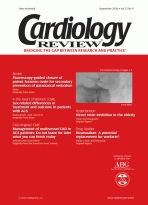Left ventricular apical ballooning syndrome: A case report of an unusual syndrome
A 65-year-old woman with a history of anxiety disorder, dyslipidemia, and recently diagnosed celiac sprue was transferred to the heart center after presenting to a peripheral community hospital with marked fatigue, progressively worsening dyspnea on exertion, and bilateral lower extremity swelling with associated bilateral arm tingling.
A 65-year-old woman with a history of anxiety disorder, dyslipidemia, and recently diagnosed celiac sprue was transferred to the heart center after presenting to a peripheral community hospital with marked fatigue, progressively worsening dyspnea on exertion, and bilateral lower extremity swelling with associated bilateral arm tingling. She reported having had recent emotional and physical stress after losing her job 2 months earlier and having bouts of severe diarrhea with associated episodes of dehydration requiring 3 hospital admissions for fluid resuscitation and electrolyte repletion. She was referred to the heart center because of electrocardiographic changes suggestive of an inferolateral non-ST-segment myocardial infarction (NSTEMI) and an elevated troponin I level of 3.97 ng/mL, even though she denied chest pain. She had a brain natriuretic peptide (BNP) level in the 900s, with an estimated left ventricular ejection fraction (LVEF) of 15% to 20%. The patient, who was not diabetic, hypertensive, or a smoker, had undergone colon cancer resection 19 years earlier. She had no family history of coronary artery disease.
Results of the physical examination showed that the patient had hypotension, tachycardia, jugular venous distension, bilateral crackles up to the midchest, the third heart sound, and bipedal pitting edema. An initial chest x-ray was suggestive of congestive heart failure. The patient’s BNP level was in the 1400s. An echocardiogram performed at the bedside showed moderately reduced global left ventricular systolic function (estimated LVEF, 30%-35%) with apical akinesis, normal right ventricular systolic function, mild diastolic dysfunction, and normal left ventricular cavity size and wall thickness. The initial troponin I level was 0.45 ng/mL, and subsequent levels were normal.
The patient was promptly started on dobutamine (Dobutrex) intravenous infusion for cardiogenic shock, as well as a heparin (Hep-Lock; HepFlush-10) drip, aspirin, and clopidogrel (Plavix) for NSTEMI. On the second day of admission, carvedilol (Coreg) was introduced into her medication regimen after she was weaned off dobutamine. She also responded appropriately to gentle diuresis with furosemide (Lasix) and was started on the angiotensin-converting enzyme inhibitor captopril (Capoten). Coronary angiography performed on hospital day 3 showed normal coronary arteries with severe anterolateral, apical, and inferior hypokinesis, and basal segment hyperkinesis was shown on left-sided ventriculography (
). These findings were compatible with left ventricular apical ballooning syndrome, so-called “takotsubo” cardiomyopathy.
The patient returned to the coronary intensive care unit after cardiac catheterization, where her symptoms continued to improve. Her drug regimen included aspirin, furosemide, carvedilol, captopril, simvastatin (Zocor), and pantoprazole (Protonix); clopidogrel and heparin intravenous infusions were discontinued after the coronary angiography results were obtained. The patient also received intravenous antibiotics for hospital-acquired pneumonia.
The patient was “downgraded” to the telemetry unit on hospital day 4. She experienced no complications during her hospital stay and was maintained on a gluten-free diet, with remission of the celiac sprue. She resumed taking her preadmission medication (alprazolam [Xanax]) for anxiety disorder.
After evaluation by the physical therapy department, the patient was transferred on hospital day 6 to a subacute facility for inpatient rehabilitation. An echocardiogram performed on the day of the transfer showed a calculated LVEF of 32%, as well as segmental wall motion abnormalities unchanged from previous studies. The patient was advised to follow up with the cardiology department for LVEF monitoring.
Stress-induced cardiomyopathy, also known as transient left ventricular apical ballooning, broken heart syndrome, and, in Japan, takotsubo cardiomyopathy, is an increasingly reported syndrome.1-9 The name takotsubo relates to the shape of the left ventricle on end-systolic ventriculography, which resembles a pot for octopus fishing of the same name. The typical presentation is acute chest pain or dyspnea in a postmenopausal woman aged 60 to 75 years after psychological stress, with electrocardiographic changes that mimic an acute myocardial infarction and characteristic findings of apical ballooning on left-sided ventriculogram or echocardiogram and absence of obstructive lesions on coronary angiography.2-7,10 Catecholamine surge-induced microvascular spasm leading to myocardial stunning has been implicated, and almost all patients with takotsubo cardiomyopathy recover completely within 2 to 4 weeks.1,2,4-6,11,12 Although this condition appears infrequently, clinicians should prudently consider this syndrome in the differential diagnoses of chest pain and dyspnea, especially in postmenopausal women with a recent history of emotional or physical stress. Stress-induced cardiomyopathy is a transient disorder managed with supportive therapy, and optimal long-term therapy has not been defined. Late sudden death and recurrent disease have occasionally occurred.1,2,4
